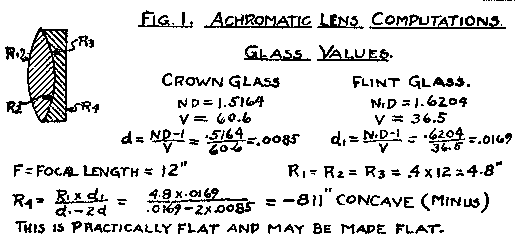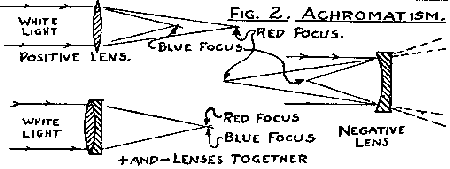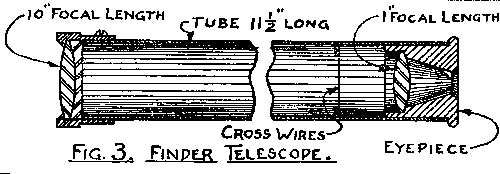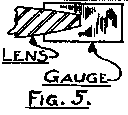 |
 The difference between the refraction of red and blue light by a certain kind of glass is known as its dispersion. This is not the same for all kinds of glass; a flint-glass lens or prism dispersing the light about twice as much as similar lens or prism of crown glass. An achromatic lens is made by combining a positive lens of crown glass with a negative lens of flint glass which has the same amount of dispersion as the crown. Since the flint glass is negative, its dispersion is opposite to that of the positive crown lens; and when we combine them their dispersions are neutralized and the red and blue rays come to the same focus. (Fig. 2) The combination will be positive; for, owing to the high dispersive power of the flint glass, the negative lens will be only about half as powerful as the positive lens when their dispersions are equal in amount.
In calculating an achromatic lens a great deal of advanced mathematics may be used; but we shall do very well by certain simple rule of thumb methods.
The difference between the refraction of red and blue light by a certain kind of glass is known as its dispersion. This is not the same for all kinds of glass; a flint-glass lens or prism dispersing the light about twice as much as similar lens or prism of crown glass. An achromatic lens is made by combining a positive lens of crown glass with a negative lens of flint glass which has the same amount of dispersion as the crown. Since the flint glass is negative, its dispersion is opposite to that of the positive crown lens; and when we combine them their dispersions are neutralized and the red and blue rays come to the same focus. (Fig. 2) The combination will be positive; for, owing to the high dispersive power of the flint glass, the negative lens will be only about half as powerful as the positive lens when their dispersions are equal in amount.
In calculating an achromatic lens a great deal of advanced mathematics may be used; but we shall do very well by certain simple rule of thumb methods. |
 Fig. 3 shows a finder telescope with an achromatic objective. As in all telescopes, the focal plane of the objective should coincide with that of the eyepiece. The cross wires are also placed at this common focus. To make the cross wires, cut out a washer-shaped diaphragm, large enough so that when pressed into the telescope tube it will remain where placed. Punch or drill four small holes equally spaced, and thread through them a fine copper wire crossing at the center of the washer. Blacken the wires by heating them with a match. A single-lens eyepiece is shown, but of course any kind may be used. If it is a Huyghenian, the cross-wires should be placed on the diaphragm between the two lenses of the eyepiece. This may be pushed from the eyepiece tube and replaced after fitting with wires. If the eyepiece is of the Ramsden type, the cross-hairs are placed in front of the field lens of the eyepiece. In any case the cross-wires should be in perfect focus when observed through the eyepiece.
Fig. 3 shows a finder telescope with an achromatic objective. As in all telescopes, the focal plane of the objective should coincide with that of the eyepiece. The cross wires are also placed at this common focus. To make the cross wires, cut out a washer-shaped diaphragm, large enough so that when pressed into the telescope tube it will remain where placed. Punch or drill four small holes equally spaced, and thread through them a fine copper wire crossing at the center of the washer. Blacken the wires by heating them with a match. A single-lens eyepiece is shown, but of course any kind may be used. If it is a Huyghenian, the cross-wires should be placed on the diaphragm between the two lenses of the eyepiece. This may be pushed from the eyepiece tube and replaced after fitting with wires. If the eyepiece is of the Ramsden type, the cross-hairs are placed in front of the field lens of the eyepiece. In any case the cross-wires should be in perfect focus when observed through the eyepiece.| Crown | Nd = 1.516 V = 64.0 d = 0.0081 | BSC2 |
| Flint | Nd = 1.620 V = 36.4 d = 0.0171 | F4 |
| 1. | R1 = R2 = R3 = .4 X 60 = 24". | |
| 2. | R4 = (R1 x d1)/(d1 - 2d) | |
| = (24 x 0.0171)/(0.171 - 0.0162) | ||
| = (24 x 0.171)/0.0009 = 456". |
 As rough-grinding nears completion, remove the crown disk from the bench and measure the edge with a caliper made by filing a notch in a piece of sheet brass to fit the edge of the lens as shown in Fig. 5. You will probably find one part of the edge thicker than the other; and this must be remedied by turning the edge of the lens toward you and pressing harder at the beginning of the stroke in grinding. When the edge measures the same all around, you are ready to fine-grind.
As rough-grinding nears completion, remove the crown disk from the bench and measure the edge with a caliper made by filing a notch in a piece of sheet brass to fit the edge of the lens as shown in Fig. 5. You will probably find one part of the edge thicker than the other; and this must be remedied by turning the edge of the lens toward you and pressing harder at the beginning of the stroke in grinding. When the edge measures the same all around, you are ready to fine-grind. It is immaterial whether the lens or the lap be held in the hand; but, if the lens is on the table, it should be turned at frequent intervals; or, better, hold it on a barrel or pedestal so that the worker can move completely around it while find grinding and polishing.
It is immaterial whether the lens or the lap be held in the hand; but, if the lens is on the table, it should be turned at frequent intervals; or, better, hold it on a barrel or pedestal so that the worker can move completely around it while find grinding and polishing. |